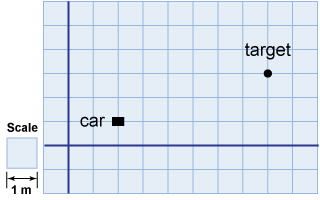|
When studying motion in two dimensions, we need to specify two numbers to describe a displacement, velocity, or acceleration vector. The two numbers can be x and y (Cartesian) coordinates or a magnitude and an angle (polar coordinates). The resultant (sum) of two or more vectors can be calculated by separately adding the vectors’ Cartesian coordinates. When a boat is rowed across a flowing river, or an airplane flies in windy air, the vehicle’s velocity must be added to the current or wind vector to predict how the motion will appear from the ground. 
|
|
displacement, polar coordinates, Cartesian coordinates, compass, velocity, speed, acceleration
|
|
|
|
Review problems and questions |
|

- A programmable toy car has to reach the target shown here. Which of the following vector sums will displace the car from its starting point to the target?
- (1, 5) m + (2, −3) m + (3, 1) m
- (3, 1) m + (2, −2) m + (1, 3) m
- (1, 4) m + (2, −2) m + (3, 3) m


|
Choice b will bring the car to its target. The target is 6 m to the right of the car (that is, 6 m in the positive x-direction). Therefore the three x-components must add up to six. Furthermore, the three y-components must add up to 2 m. All three choices yield an x displacement of 6 m, but only choice b yields a displacement of 2 m in the positive y-direction. 
|

- Match each of the labeled vectors (a through d) with one of the following expressions, given in polar coordinates. (Each square on the grid represents one meter of displacement.)
(i) (2 m, 90°) (ii) (5 m, −30°) (iii) (7 m, 45°) (iv) (3 m, 120°) 

|
 a corresponds to iii.
a corresponds to iii.
b corresponds to ii.
c corresponds to i.
d corresponds to iv.
In this case, the polar angle suffices to distinguish between the vectors. You should check, however, that the vector lengths agree with the r-coordinate (in meters). 
|
- A rowboat rests on the southern bank of a river of width 20 m that flows from west to east. The rowboat is moored 60 m west of a treacherous waterfall. Jamie is capable of rowing the boat at a speed of 2 m/s northward (the boat’s velocity with respect to the flowing water). The river current flows at a rate of 4 m/s eastward the water’s velocity with respect to the ground). Jamie enters the boat and begins to row.
- Sketch a diagram of the scenario (as seen from above), with the velocity vectors oriented correctly and drawn to scale.
- What is the boat’s velocity (in meters per second) with respect to the ground? (Provide components as well as the speed and approximate compass heading.)
- Can Jamie reach the northern riverbank before the current carries him into the waterfall?


|

- The sketch depicts the relative width and length of the river as well as the directions and relative speeds of the given velocities.
- With respect to the ground, the boat has a velocity of (2 N, 4 E) m/s (approximately 4½ m/s toward the ENE).
- Using the formula t = dy/vy, we can calculate that it will take Jamie 10 s to cross the river at 2 m/s. During that time, the current will carry him 40 m eastward. Since he begins to row 60 m west of the waterfall, he will be able to reach the northern bank in time.

|
Take a Quiz |
| |
|

